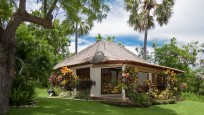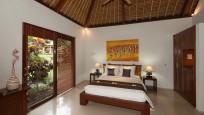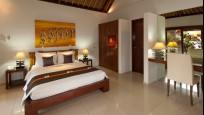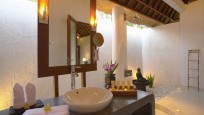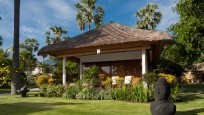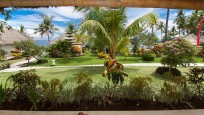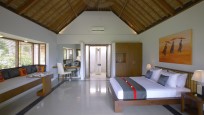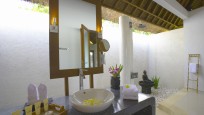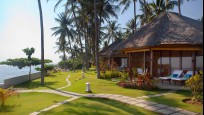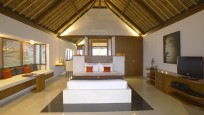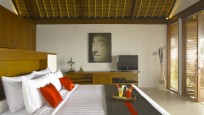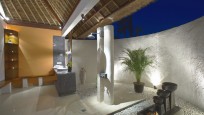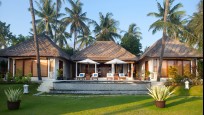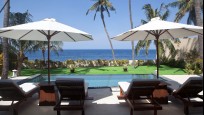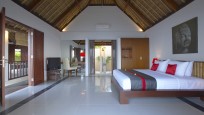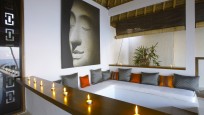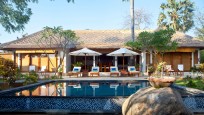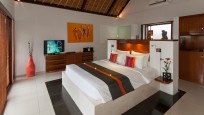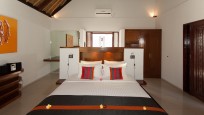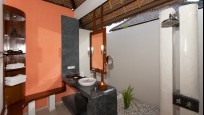Siddhartha Ocean Front Resort & Spa
- Nitrox
- Internet
- PADI
- SSI
- Restaurant
- Swimming pool
- Airport Transfer
- Spa/Massage
- Gym/Fitness
- Bar
The Siddhartha Ocean Front Resort & Spa, built in 2009, set a new standard for hotels in the North-Eastern region of the island. This hotel offers you the luxury of a Boutique-Hotel with stunning architecture in a fabulous setting, yet prices are still reasonable. Something that you too, can afford! In spite of the luxury, the mood here is nevertheless informal & relaxed. You will be able to truly relax & unwind. It is a great resort meeting upmarket expectations.
Accommodation
-
1 Superior Bungalow
Book nowEach of the 7 superior bungalows has a living area of 45m² including a large terrace equipped with teak sunbeds.The bungalows are all light with modern furnishings and all have double beds.
All of the luxurious bathrooms are made of natural stone with two showers: a rainfall shower and a waterfall shower.
Facilities: air conditioner, electric fan, safe, minibar, telephone, tea/coffee making facilities, hair dryer, WLAN connected. -
2 Deluxe Bungalow
Book nowEach of our 18 deluxe bungalows has a living area of 55m² including a spacious terrace equipped with teak sunbeds. The bungalows are all light with modern furnishings and all include an additional day bed.
All of the luxurious bathrooms are made of natural stone with two showers: a rainfall shower and a waterfall shower.
Facilities: air conditioner, electric fan, safe, minibar, telephone, tea/coffee making facilities, hair dryer, WLAN connected. -
3 Oceanfront Deluxe Bungalow
price per day: 95 USDBook nowThese 5 bungalows directly overlook the ocean with a living area of 65 m2 including a spacious terrace equipped with teak sunbeds. The bungalows are all light with modern furnishing, additional day bed and a king size bed facing the ocean.
The luxurious, semi circular and spacious bathrooms are made of natural stone with two showers: a rainfall shower and a waterfall shower.
Facilities: air conditioner, electric fan, safe, TV/DVD & stereo set, minibar, telephone, tea/coffee making facilities, hair dryer, WLAN connected. -
4 Villas Pantai & Santai
price per day: 149 USDBook nowThese two dream villas each have their own gigantic terrace (150m²) and two separate bedrooms with en-suites. Separated by the main area, where you will find the living room and kitchen. These bungalows are luxuriousy furnished and are modern, yet comfortable.
Facilities: air conditioner, electric fan, minibar, telephone, hot and cold water, tea/coffee making area, Satellite TV, DVD, stereo and a roomsafe. -
5 Villa Taman
price per day: 117 USDBook nowThis villa is in a beautiful private tropical garden (400m²). Of course it includes a private pool.
This dream villa also has a private terrace (150m²) and two separate bedrooms with en-suites. Separated by the main area, where you will find the living room and kitchen. These bungalows are furnished in a similar way to the Santai and Pantai villas.
Facilities: air conditioner, electric fan, minibar, telephone, hot and cold water, tea/coffee making area, Satellite TV, DVD and stereo and a roomsafe.
Dining
The Siddhartha Ocean Front Resort & Spa restaurant offers traditional Indonesian and Asian delicacies created with the finest local produce. You can find also a variety of international specialites, vegetarian and vegan delights. The bar offers wiine list, selective choice of local and international wines or alternatives to wines.
Diving
The dive center is situated 50m from the shore. As all other Werner Lau dive centers, it was built for divers, by divers. This dive center has everything you’d expect from a Werner Lau facility. It is a full-service facility with a modern boat, air conditioned cars, dive shop, well equiped work shop, gear rinse and storage. There are 92 x 12 litre and 8 x 15 litre aluminium tanks (DIN & INT). Nitrox is produced by a NRC membrane system and is free of additional charge.
- Free Nitrox
- DIN Tanks
- Kubu Dives 39$
- Night Dive 52$
- Tulamben Early Morning Dive 52$
- Day trip Amed 117$
- Day trip Menjangan 176$
- Day trip Nusa Penida 164$
- Day trip Padangbai 140$
- Day trip Secret Bay 176$
Dive Courses
Dive courses are available from Open Water Diver to Divemaster SSI,PADI and CMAS.
An additional certification fee of EUR 38.50 for all SSI, PADI and CMAS courses must be paid locally.
PADI manual fee of €110.-- for all PADI courses will be charged locally.
- Open Water Diver 386$
- SSI Advanced Adventurer 322$
- Enriched Air Diver / NItrox 199$
- SC Deep Diving 258$
- SC Drift DIver 258$
- SC Navigation 258$
- SC Perfect Buoyancy 258$
- SC Wreck Diving 258$
- SC Boat Diving 258$
- SC Night & limited Visibility 258$
- SC Diver Stress & Rescue 386$
- DiveCon / Divemaster 799$
Equipment Rental
Dive gear rental is available. The resort own 30 BCDs; 30 regulators with octopus SPG & inflator hose; 25 sets of masks, fins & snorkels; 30 wetsuits (3mm shorties & 3mm long); 15 dive computers; 10 torches; 1 digital underwater camera
- Snorkeling equipment 10$
- Complete Scuba equipment 30$
- BCD 7$
- Regulator 7$
- Wetsuit (Shorty) 7$
- Wetsuit (3mm long) 10$
- Hood 4$
- Torch per dive 7$
- Computer 7$
- SMB 6$
Facilities
- Restaurant
- Bar
- Swimming pool
- Pool bar
- Lobby/Reception
- Gym/Fitness
- Spa
- Dive Center
- Library
Services
- Daily Housekeeping
- Laundry Service
- Massage
- Airport Transfer
- Audio & Video Entertainment
- Paid WI-FI
- Tours
- Room Service
Activities
Apart of scuba diving the Siddhartha Ocean Front Resort& Spa in Kubu is an excellent starting point for cultural excursions and adventure-tours.
The resort offers standard and personalised tours. In comfortable and air conditioned minibusses you can visit local rice fields, coffe, cocoa and spice plantations, villages and some of the cultural highlighs of this island.
Some of the most beautiful destinations include the Kintamani with views of the Batur volcano; Ubud, the cultural and spirtual centre of Bali with its thriving markets and diverse artist workshops; Singaraja, the old Dutch capital of Bali, Tenganan, Besakih, Bedugul or Bratan.
There is extensive list of more adenturous excursions; from exciting wildwater rafting trips on the Agung river to quadbiking through the untamed nature trails or even by climbing Mount Batur or Mount Agung, the highest and holiest mountain in Bali.
All extra activities to be booked locally on request.
-
Bunutan
Amed-Bunutan is around 10 min with the local Fishermen boat from Jemeluk bay. Starting from the sand slope, you will see an an impressively large school of Garden eels at around 12m. After the Garden eels, we would expect to do a gentle drift which enables us to effortlessly see amazing Barrel sponges, Blue-spotted rays, beautiful sea fans, schooling barracudas, Giant trevally, a wide variety of reef fish and some resident White-tip reef sharks.
-
Drop Off (Amed)
Difficulty: 1 to 2 Current: Mild to medium Tips: Turtles, tunas, napoleon wrasse This divesite is reached within a 30min car drive from the Siddhartha or 60 min by car from Alam Anda and an additional 5min boat drive by Jukung(traditional outtrigger boat). On this site we will drift along a steep wall going down to a depth of more than 60m, covered with untouched colorful hard – and soft corals. There is almost always some current present but as a drift dive this divesite is recommended for all levels of experience. In the blue away from the wall we often spot whitetipped reef sharks, turtles and napoleon wrasses.
-
Gili Selang (Amed)
Difficulty: 3 to 5 Current: Medium to strong Tips: shallow lagoon containing one of the best reefs in Bali, steep drop off The dive site Gili Selang is reached from the Siddhartha after a 45min car drive and an additional 15min jukung drive(traditional outtrigger boat). Gili Selang is a small rocky island lying off Balis most eastern point. Because of its exposed location in the Lombok Strait, currents are always possible. The little island is separated from Bali trough a 6mtrs deep and 12mtrs wide channel. We start our dive on the north side of the island in a shallow lagoon with a max. depth of 18mtrs. The lagoon is covered with many coral boomies and many soft corals. The current will take us to a steep drop off (45° angle) which leads to extreme depths. Because of the current, we should always have a look in the blue to have a chance to spot tunas, turtles and possibly even hammerhead sharks here. All the typical reef fish: bat fish, octopus, a variety of small crabs, many different nudibranchs, turtles, whitetip reef sharks, tunas and mackerels can be seen at this incredibly diverse divesite.
-
Jemeluk (Amed)
Difficulty: 1 to 2 Current: Mild to medium Tips: Turtles, frogfish, pygmy seahorses 30min by car from the Siddhartha plus additional 5min by Jukung (traditional outtrigger boat) We start our dive from a 10 m deep sandy plateau with thousands of garden eels and countless stingrays. Following is a gentle slope through a coral garden to about 20 m, where we find big artificial reefs in a pyramid shape, full of corals. Here we often find pygmy seahorses, leaf scorpionfish and frogfish. A paradise for photographers and macro fans. Afterwards we are drifting along a drop off where we almost always can find turtles, napoleon wrasses, octopus and cuttlefish. Some current should always be expected, but this divesite is very easy to handle as a drift dive.
-
The Japanese Wreck (Amed)
Difficulty: 0 to 1 Current: none to mild Tips: a small steel wreck surrounded by a wonderful coralgarden The Japanese wreck is situated in a quiet bay, southeast of Amed. This 20m long steel wreck lies at a depth of 2-12mtrs. Apparently, this was a Japanese patrol boat which sank during the War. It is covered with countless soft corals and a large variety of colourful fish live here. Going over the slope, which is overgrown with soft and hard corals you reach the bay. The slope starts at a depth of about 5m and goes down to around 35m. At this depth there is a rock with a coral plateau. The sea floor is sometimes sandy, in other places covered with black coral, sponges and gorgonian sea fans and is inhabited by an enourmous diversity of small creatures. Besides the typical variety of tropical fish, many kinds of nudibranches and other small life, scorpion fish, ghost pipefish, seahorses, whitetip reef sharks, tuna, turtles and a lot more can be found.
-
Blue Corner (Nusa Lembongan)
25 - 35 min. per boat from Padangbai Difficulty: 4 to 5 Current: medium to strong Tips: Big fish, swarm fish as well as delicate underwater life Nusa Lembongan Blue Corner is the end of a diving spot which begins at the fringing reef of Lembongan Mangrove. The current here is always running in the same direction which can cleary be seen in the formation of the gorgonian sea fans. This spot is situated on the north tip of Lembongan and consists of a drop-off with many overhangs and a wide canyon at a depth of approx.40mtrs. The Blue Corner is the highlight of this dive site. Eagle rays, groupers, whitetip reef sharks, manta rays, turtles and rays can almost always be seen here. In addition to the above-mentioned animals we can also find mackerels, snappers, tunas, moray eels, barracudas and a large variety of tropical reef fish. Also small creatures such as shrimps, pygmy seahorses, pipefish and clams can be seen, although it is more interesting to look into the fish soup.
-
Buyung (Nusa Penida)
25 - 35 min. per boat from Padangbai Difficulty: 3 Current: medium to strong Tips: beautifull corals, big fish and shoals of fish Nusa Penida Buyung is located on the north side of the island and starts, the same as Nusa Penida S.D., Ped, Sental and Kutapang, with a shallow reef platea which drops at a depth of approx. 10mtrs at a 45° angle to extreme depths. Here, too, is an amazing growth of hard and soft corals as well as whip corals. Many small creatures, cleaner fish and numerous nudibranchs live here along with lion fish and leaf fish and moray eels. Out in blue water, reef sharks, eagle rays and many other large sea creatures often pass by. So don’t forget to also look out into the blue. At this site you also find glass fish, fairy basslets, nudibranchs, cleaner shrimps, cleaner fish, leaf fish as well as large quantities of all kinds of tropical fish. Also eagle rays, mola mola (Sun fish) and various species of reef sharks, turtles, tuna, mackerels and shoals of fusiliers.
-
Crystal Bai (Nusa Penida)
35min. boat-drive from Padang Bai Difficulty: 3 to 5 Current: moderate to strong Tips: Mola Mola (August-September) fantastic coral growth! Nusa Penida Christal Bay is a bay which lies directly in the channel between Nusa Penida and Nusa Caningan on the south east side of Nusa Penida. The current in the channel can be very strong and can keep changing direction. Often, we also experience up and down currents. The visibility is approx. 20 – 50m. In the bay itself though, we are relatively protected from these currents. The bay stands out because of its emourmously healthy growth of soft and hard corals. We can see many different species of coral fish here. We are also often able to report encounters with white tip reef sharks and tuna. The main reason to dive Crystal Bay is that this is the place where we most commonly encounter mola mola in the late summer months (August-September). Please be aware that the upwelling currents do bring colder water up from the deep, 17-24 degrees is not uncommon, which the Mola Mola seem to prefer. In Crystal Bay one can commonly encounter sea snakes, large moray eels and unique species of nudibranchs, but don’t forget, always keep an eye in the blue when you dive in Crystal Bay.
-
Kutapang (Nusa Penida)
25 - 35 min. per boat from Padangbai Difficulty: 3 to 4 Current: strong Tips: a dive site, which guaranties a tru “fish soup” Nusa Penida Kutapang. This diving spot is situated in the north of the island. At a depth of approx. 10m this very shallow reef plateau drops steeply down at a 45° angle to bottomless depths. Steep slopes and drop-offs with lots of crevices and overhangs offer space for all kinds of hard and soft corals, fan corals and whip corals. On the reef itself lots of the more delicate sea life can be observed. Many types of flatworms, pipefish, cleaner shrimps, small crabs and moray eels live here. As at all diving spots around Nusa Penida, here, too you should always keep an eye out into the blue so as not to miss any of the larger sea creatures which could be passing. Many shoals of fish hover in the current here increasing the feeling of being in a fish soup. As already mentioned, lots of larger sea creatures can be seen here, such as eagle rays, manta rays, mola mola (Sun fish), different types of reef shark, green and hawksbill turtles, tuna, giant trevallys, shoals of fusiliers as well as most types of south east Asian fish.
-
Mangrove (Nusa Lembongan)
25 - 35 min. per boat from Padangbai Difficulty: 2 to 3 Current: medium to strong Tips: Big fish, shoals of fish as well as delicate underwater life Nusa Lembongan Mangrove was named after the large mangrove area between Lembongan and Ceningan. It is a relatively gradual slope with huge sponges, soft and fan corals. Sharks, turtles and many other kinds of large sea creatures can be seen here as well as shoals of fish such as mackerels, snappers, tuna and barracudas which hover in the current. This spot is well known for the large quantity of fish – a real “fish soup”. Emperor fish, trigger fish and sweet-lips round up the picture. In addition to the above mentioned we also can find a large variety of tropical reef fish here as well. Also small creatures such as shrimps, pygmy seahorses, pipefish and clams can be seen.
-
Manta Point (Nusa Penida)
45 min. per boat from Padangbai Difficulty: 2 to 3 Current: mild to moderate Tips: The spot for Manta Rays! Best season is September to June but Manta Rays are there all year. Nusa Penida Manta Point is situated off the south east side of Nusa Penida and is known for its manta rays all year round. The best diving season is September to June due to the calmer seas during this period. The dive site comprises of a large area which is too big to cover in one dive. We travel with the speed boat from Padangbai in the direction of the channel which divides the island Nusa Penida from ist smaller neighbouring island Ceningan. The Manta Point itself starts behind a rocky headland and is protected from the current. Large boulders in the shallow water create a bizarre underwater topography. The site has a sandy slope from 5mtrs to 12mtrs, continuing afterwards to a depth of 30mtrs. Visibility in this bay is about 10-15mtrs.We reach our destination - several large boulders – after only a few minutes. Here are several cleaning stations, where the manta rays “land” regularly. But even on the way to the cleaning stations the manta rays leisurely glide past us. In addition to the manta rays, nurse sharks have been seen here frequently. Naturally, here are manta rays, manta rays and more manta rays! But also large quantities of tropical fish, emperor fish, scorpion and lion fish, moray eels and a lot of shrimps, mussels, crustaceans and nurse sharks in the sand.
-
Ped (Nusa Penida)
25 - 35 min. per boat from Padangbai Difficulty: 2 to 3 Current: medium to strong Tips: beautiful wall, good chance for pelagic fish as well as for delicate fish life Nusa Penida Ped is situated in the north of Nusa Penidas and starts with a very shallow reef plateau, which drops at approx. 10mtrs down to extreme depths. Steep slopes and steep walls covered with hard and soft coral predominate at this dive site. In crevices, ledges and overhangs shoals of glass fish, cleaner shrimps and numerous moray eels, lion fish, stone and scorpion fish can be found. Clouds of fairy basslets hover over the corals making the scene flicker. Always take a look out into blue water. As at Nusa Penida SD there is always the possibility of larger sea creatures. Along with many other typical types of fish, fairy basslets, lion fish, shoals of mackerels, tuna, fusiliers and barracudas can be found. Also on the list are passing white tip reef sharks and green turtles.
-
SD (Nusa Penida)
25 - 35 min. per boat from Padangbai Difficulty: 2 to 3 Current: medium to strong Tips: beautiful wall, good chance for pelagic fish Nusa Penida SD is situated in the north of Nusa Penida. The dive site begins with a very shallow reef plateau. Sloping down to approx. 10mtrs where it drops at a 45° angle down to extreme depths. Steep slopes alternate with steep walls. An amazing growth of hard and soft corals can be found here including numerous whip corals. Large clouds of banner fish hover in the current above the corals. If you take the time to explore the reef in detail, there are many smaller creatures and a huge selection of nudibranches to be found here. But don’t forget to keep looking out into the blue. Again and again, large shoals of fish and pelagic creatures such as eagle rays, tuna, manta rays, mola mola (Sun fish), various kinds of reef shark and green turtles have been seen. A “must” for all experienced divers! -
Sental (Nusa Penida)
25 - 35 min. per boat from Padangbai Difficulty: 2 to 3 Current: medium to strong Tips: beautiful wall, good chance for pelagic fish as well as for filigree fish life Nusa Penida Sental is situated on the north side of the island and starts, just like Nusa Penida SD, Ped, Buyuk and Kutapang with a shallow reef ceiling which then drops off at a 45° angle to extreme depths at 10mtrs. Here, too, there is an amazing growth of hard and soft corals, including many whip corals. Many small creatures, cleaner fish and countless nudibranches make the hearts of all macro fans beat faster. Even so, here too, always keep an eye out into blue water so as not to miss the pelagic creatures which may pass by. This is not difficult due to the extremely clear water. Glass fish, fairy basslets, nidubranches, cleaner shrimps, cleaner fish, frog fish, leaf fish, seahorses as well as countless species of tropical fish can be found here. Also the larger sea creatures such as eagle rays, mola mola (sun fish), various reef sharks, green and hawksbill turtles, tuna, giant trevelly and shoals of fusiliers can be seen.
-
Bias Tugal (Padang Bai)
10 min from Padang Bai Difficulty: 0 to 2 Current: none to mild Tips: dive site with lots of small marine life, Bias Tugal is located in the bay just in front of the sandy beach of Bias Tugal. The sandy bottom of the bay slopes down from 10 to 20mtrs until we reach the drop off. The bottom of the bay is covered with lots of soft and hard coral. In the sandy area between the coral fields we often can see sleeping white tip reef sharks and sting rays. It is well worth looking into the blue at the drop off since there are sometimes big fish passing through. We can find sweetlips, puffer and box fish, clown fish, cleaner fish, octopuses, moray eels, stingrays, scorpion and lion fish, whitetip reef sharks and all kinds of tropical marine life.
-
Blue Lagoon Tanjung Sari (Padang Bai)
10 min from Padang Bai Difficulty: 2 Current: mild to medium Tips: many shoals of fish Blue Lagoon Tanjung Sari is located on the southern end of the lagoon directly next to the headland between Blue Lagoon and Padangbai. The top of the reef starts at 5mtrs and slopes gently to 30mtrs. There the reef ends in the sand. Because the dive site is right next to the headland protruding into the open sea there is always current. In the shallower area there is a kind of lava stone labyrinth. Here, sheltered from the current, is the way back into the lagoon. Various kinds of reef sharks, turtles, moray eels, all sorts of colourful coral fish as well as small creatures such as prawns, nudibranchs, tubeworms, sea needles, lion fish, anemone fish and more can be found.
-
Blue Lagoon Temple (Padang Bai)
plus 10 min by speedboat Difficulty: 0 to 1 Current: none to mild Tips: very interesting dive site for macro fans, Black Tip Reef Sharks The Lagoon Temple starts in the Blue Lagoon, going out towards the south. We find here a very beautiful growth of hard and soft corals from a depth of 5mtrs. The dive site slopes from about 12mtrs to a maximum of 30mtrs. On the slope are many coral formations which provides a habitat for all kinds of small creatures. The current is perfect here, with very small waves. In the sandy bottom sand eels, gobies, shrimps and clams can be found. Sharks often accompany us at this spot, black tip reef sharks can be encountered here as well as octopuses, nudibranches, tubeworms, moray eels, anemones, clown fish and shoals of batfish.
-
Blue Lagoon Wall (Padang Bai)
10 min via speedboat from Padang Bai Difficulty: 1 to 2 Current: none to medium Tips: beautiful steep wall, a must for macro fans Blue Lagoon Wall is the name of a dive site in Padangbai which we dive in a northerly direction from the bay. We start the dive in the bay which has a maximum depth of 10mtrs. Directly at the northern exit of the bay the drop-off starts at a depth of 5mtrs going down to 30mtrs. The wall is wonderfully overgrown with hard and soft corals and is inhabited by lots of small creatures such as crabs, prawns, cleaner shrimps and countless feather stars in all different colours. Frogfish and also leaf fish can often be found here. Apart from the usual diversity of small species for which Bali is known this spot also offers a large spectrum of colourful reef fish. Clown fish, lion fish, scorpion and stone fish, octopus, moray eels, the occasional lobster, nudibranches and banner fish.
-
Gili Biaha (Padang Bai)
30 min. boat ride from Padangbai Difficulty: 3 to 5 Current: moderate to strong Tips: good chances for big fish, cave with sleeping white tip reef sharks Gili Biaha is a small rocky island, 30 minutes away by boat from Padangbai. Because Gili Biaha rises out of the deep sea, it offers good chances of encountering large fish. The whole dive site is a collection of sloping reef and steep walls. Starting at 5mtrs, it then descends in steps past 12mtrs and 20mtrs to unreachable depths. At about 7mtrs, on the side facing the open sea is a cave in which we have a good chance to encounter sleeping whitetip reef sharks. The side facing towards the beach drops down at an angle of about 45° to unreachable depths. Here we find a superb growth of hard and soft corals. Moray eels, tuna, barracudas, turtles, octopuses and whitetip reef sharks can be seen here as well as the typical diversity of Asian reef fish. There are many shoaling fish such as fusiliers, snappers, mackerels and batfish.
-
Gili Mimpang (Padang Bai)
5 min. boat ride from Padangbai Difficulty: 3 to 5 Current: strong Tips: lots of big and swarm fish life Gili Mimpang is a collection of small rocky islands 15 minutes away by boat from Padangbai. Here, too, because of ist position in the open sea, there is a good chance of encountering large fish. The underwater topography is varied, including everything from a sandy area beginning at 5m to a coral reef sloping down at an 45° angle to a imposing drop-off which goes from 30 to 50mtrs and deeper. On the northwest side is a sandy area where we always find sleeping whitetip reef sharks at about 20 – 25mtrs. In addition to the typical variety of coral fish there is often the chance of seeing whitetip reef sharks, the occasional blacktip reef shark, shoals of snappers, mackerels, tuna, sometimes manta rays and with a bit of luck maybe even a mola mola (sunfish).
-
Gili Tepekong (Padang Bai)
10 min. boat ride from Padangbai Difficulty: 3 to 5 Current: strong Tips: pelagics and schooling fish We reach Tepekong after a 10min boat ride from Padang Bai. On the southwest side of this cliff island we will find the famous “Canyon” that only can be dived with experienced divers and when conditions are perfect. On the east side one will come across pristine sloping coral reefs. The entrance-point is marked with a buoy. The sloping coral reef will be followed with the reef on your left shoulder. Here one can come across large schools of fish and whitetip reef sharks. From time to time Mola Molas also find their way to Tepekongs cleaning stations. One should keep their eyes in the blue to find the eagle rays, devil-rays tunas and napoleon wrasse that pass by in the current. Tepekong is a big-fish dive site, but also hosts an enormous biodiversity with many different species of rare shrimps and nudibranchs.
-
Jepun
10 min from Padang Bai Difficulty: 0 to 2 Current: none to mild Tips: dive site with lots of small marine life Jepun is one of the prime muck-dives in Bali. The entrance-point is west of a mooring platform of a semi submersible boat. In the shallow area of the dive site a healthy coral garden stretches from the beach to a depth of 10m. Keeping the reef on your right shoulder and maintaining a depth of 18-20m one will find several artificial reefs along the sandy slope. In the artificial reefs one can encounter frogfish, ghost pipefish, leaf scorpionfish and many other rare “critters”.
-
Alam Segara
Difficulty: 0 to 1 Current: Mild to medium Tips: Baby lionfish, humphead parrotfish, nudibrachs Alam Segara is located about 10 minutes west of the Siddhartha. This dive site is about 300 m long reef which we follow in a west or east direction, depending on the current. It’s a beautiful steep reef plateau down to more than 30m, full of richly covered coral blocks, in between slopes and coral ridges leading into the deep. We find a lot of huge gorgonian fans, big table corals, all kinds of hard and soft corals. Schools of fusiliers, barracudas and even a group of humphead parrotfish can often be seen here. In the black volcanic sand surrounding the ridges we find colorful nudibranchs, scorpionfish and tiny baby lionfish. -
Batu Belah
Difficulty: 0 to 1 Current: None to mild Tips: Napoleon wrasse, frogfish, mantis shrimps Batu Belah is located 20 min away in a south-eastern direction from the Siddhartha. The reef starts in front of three small bays. A sandy and rocky slope starts at the beach and ends at 5-6m where the coral reef begins. The reef is a series of cooled off lava streams divided by sandy canyons full of critters. The coral-encrusted lava streams drop off steeply into the deep blue of the Lombok Strait. The diversity of marine life here is incredibly high, schools of fusiliers, snappers, batfish and tunas patroling the open water while nudibranchs, mantis shrimps, hairy squat lobsters and crabs live amongst the many anemones found on the reef. If lucky, one can also find giant frogfish and leaf scorpionfish on the large elephant-ear sponges.
-
Batu Kelebit
Difficulty: 0 to 2 Current: mild to moderate Tips: humphead parrotfish, whitetip reef shark, pygmy seahorses Batu Kelebit is located about 750m south-east of Tulamben Bay. The divesite consists of 3 large ridges starting at a central point in the shallows. The rigdes are abosulutely full of beautiful corals covered in clouds of colorful anthias. This dive-site offers excellent visibility and the posibility to see white-tip reef sharks, green turtles and entire herds of humphead parrotfish, with a bit of luck even pygmy seahorses and cuttlefish can be found hiding between the corals. The ridges of Batu Kelebit are surrounded by pure white sand where one can find robust ghost pipefish, fire dart gobies and even flying gurnards. Besides the typical diversity of reef fish, trevallys, batfish, sweetlips and large numbers of fusiliers can be seen here, on occasion even eagle rays are cruising by in the blue.
-
Batu niti secret
Batu niti secret is 15 minutes by boat into the next bay south east of Tulamben. The divesite is a so-called muck dive, here you will find only little coral and fish. When diving in Batu niti secret you will be searching the rich black volcanic sands for critters, and there is lots of them. Countless nudibranchs, frogfish, ghost pipefish, shrimps, flounders and much more. This is without a doubt one of the best sites in Bali to find the critters that Bali is so famous for. The highlight here are the different nudibranchs and shrimps, a must for photographers. -
Boga Wreck (Siddhartha House-Reef)
Difficulty: 2 to 3 Current: Mild to medium Tips: Wreck, shoaling barracudas, whitetip reefsharks In september 2012 a decommissioned Coastguard supply-ship was purposely sunk on the Siddhartha house-reef. The steel wreck has a length of 45m. The wreck was sunk with the purpose of creating a new habitat for marine life and it has already attracted a large array of colorful reef fish, barracudas, large honeycomb moray eels and batfish. Because of the nutrient rich currents of the Lombok Strait a wide variety of soft corals have already starting encrusting the entire wreck. The wreck lies on a sandy slope between beautiful coral patches, it lies on its keel, with the bow at a depth of 15m and the propeller at 35m. A highlight of the wreck is the easy penetrations that can be done on both of the two stories, the wreck is complete its own Volkswagen standing in the cargo hatch opening. The wreck has been made extra interesting by various objects brought down by divers, such as old scuba tanks, amphoras, Buddha statues, a tressure chest, etc. Being easily accessable from the beach next to the Siddhartha the Boga Wreck has quickly become a favorite amongst our house-reef divers, a must do on your holidays here at the Siddhartha.
-
Emerald
Difficulty: 2 to 3 Current: Mild to medium Tips: Eagle rays, pygmy seahorses, huge amounts of fish Emerald is a large lava outcrop a few minutes south-east of Tulamben. Reached by boat from the Siddhartha within only 15 minutes. The exposed location of this coral reef means that a medium current is to be expected. The site consists of three ridges dropping steeply off into the deep blue. Surrounded by white sand the ridged are completely covered in pristine coral growth and home to massive shoals of fish. The south-eastern area has the strongest current and when dived properly can be spectacular, with eagle rays cruising by in the deep and thousands upon thousands of reef fish being hunted by jackfish and tunas. This divesite is however not "only" for the big fish, pygmy seahorses are almost always to be found on gorgonian fans in the deep while juvenile ribbon eels and leaf scorpionfish will be found waiting for prey to cruise by.
-
Kubu Drop Off & Kubu Coral Garden
Difficulty: 0 Current: none to mild Tips: pygmy seahorse, rare nudibranchs, batfishs The Kubu reefs are easily accessible from the rocky lava shore or just a couple of minuttes from the Siddhartha by boat. The reef starts right off the beach in shallow water about 2-3mtrs deep featuring huge pinnacles of glassfish-covered coral heads. This site is a good snorkeling spot, too. The coral garden leads into a beautiful ridge covered with fields of staghorn coral and some good sized soft coral which sometimes host rare crustaceans like porcelain crabs and tiny little cowries snails. Please do not forget to check for pygmy seahorses on the deeper gorgonian sea fans! Nearly any kind of reef fish is abundant, schooling species like chevron barracudas or large schools of fairy basslets, but also individuals like large groupers can be seen. A very highlight would be the gorgeous juvenile pinnate batfish which hides in the dark of crevices and holes. This fish is rarely seen by divers but occasionally and, of course, with a bit of luck we can discover this beautiful animal on the Kubu reefs. Especially “macro freaks” will like this site since we have discovered many rare species of nudibranches, some of them not yet described, some still undescribed by science.
-
Palung Palung
Difficulty: 1 to 2 Current: Mild to moderate Tips: Colorful softcorals, blacktip reefsharks, hawksbill turtles Palung Palung starts in a shallow bay, after a few minutes of swimming along a pristine hard coral garden one reaches a steep slope. You dive along colorful untouched coral formations, walls and canyons, the walls and canyons are at depths between 10m to more than 40m. It has lots of intact hard and especially soft corals. When whalesharks have been spotted in the past, this was the site, so keep at least one eye in the blue! Palung Palung is also a paradise for macro-fans with pygmy seahorses, squat shrimps, porcelain crabs, fire dart gobies and colorful nudibranchs spotted on almost every dive. When the currents are right you often see large shoals of fusiliers, napoleon wrasse, humphead parrotfish and from time to time blacktip reef sharks and large hawksbill turtles.
-
Pura Gerombong
Difficulty: 0 to 2 Current: None to medium Tips: Nudibrachs, leaf scorpionfish, humphead parrotfish, barracudas Pura Gerombong is located a 10 minute boat-drive west of Siddhartha. We start the dive along a richly covered wall that begins at a depth of 7m, going down to +40m. Depending on the current we follow the reef in a western or eastern direction along the beautiful steep reef plateau. The reef is split in the middle by an alleyway of stones. In the stones one can find lots of rare shrimps, octopus, ghostpipe fishes and nudibranches. There is a small cave with lots of soldier fish inside. Coral growth includes large fan corals, table corals and lots of sponges. Many small overhangs with glass fish and lots of different species of reef fish can also be found.
-
Seraya´s Secret
Difficulty: 1 to 2 Current: None to mild Tips: Frogfish, Seamoths, Harlequin shrimps Seraya is only 15min by boat from the Siddhartha, in the next bay south-east of Tulamben. This site can also be done conveniently from the shore with suncover, toilets, washtanks and showers right at the entry point. Seraya is a so-called muck dive, here you will find only little coral and fish. When diving Seraya you will be searching the rich black volcanic sands for critters, and in Seraya, there is lots of them. Countless nudibranches, frogfish, ornate ghost pipefish, ribbon eels, bumblebee shrimps, coleman shrimps, flounders, mantis shrimp, seamoths and much much more. This is without a doubt one of the best sites in Bali to find the critters that Bali is so famous for. The highlight here is the resident pair of Harlequin Shrimps, proudly sitting on their red sea star, a must for photographers. -
Siddhartha House-Reef
Difficulty: 1 bis 3 Current: Mild bis medium Tipps: artificial structures, humhead parrotfish, turtle, spanish dancer, leaf scopion fish, lobsters The Siddhartha House-reef stretches over a length of 400m, along the shoreline of the resort and along with the beach north-west of the resort. The shallow part (3m-16m) of the House-Reef is a gently sloping coral garden full of beautiful coral blocks covered in anthias, oriental sweetlips and glassfish, in the deeper area it consists of coral blocks on a sandy slope with plenty of lionfish, leaf scorpionfish and the most beautiful juvenile angelfish. We even have our very own House-Reef Wreck, the 45m long coastguard ship, the Boga. The area directly in front of the diving center mostly has an upward-current coming to the reef from a northern direction, this up-current brings lots of nutrients which means that the reef in this area is very healthy and absolutely full of fish (4-20m), when bigger fish such as eagle rays, napoleons and turtles are spotted it is almost always in this area. On the slope in front of the hotel you will also find two artificial reefs (15-18m), already teeming with life after only being in the water since 2011. The area in front of nr. 5 consists of a sandy slope, has little or no current and is great for training and for finding special small animals such as nudibranchs, mantis shrimp, ghost pipefish, ribbon eels and cuttlefish. Perfect for photographers! To be able to reach all parts of the reef comfortably there are 6 different entries/exits to choose from, divers can start at the entry of their choice and decide during the dive which exit they will come out at. Tanks are of course carried to and from the entries by our staff, the staff will remain on the beach on lookout at all times while you are diving. The entries are marked with ropes going from the beach, along with the bottom, to a depth of 25m. The ropes are marked with signs showing the number of the entry, making it extremely easy to navigate. Early morning dives and night-dives can of course also be done our beautiful house-reef.
-
Subandar Reef
Difficulty: 0 to 1 Current: None to mild Tips: eagle rays, hawksbill turtles, large tunas, leaf scorpionfish Subandar Reef is located 15 min west behind Kubu. The reef starts in front of a small temple and slopes to 7-8 mtrs, where very large reef blocks make out canyons, trenches and walls. Subandar reef is a very healthy reef with lots of large areas of staghorn corals, large gorgonians and huge barrel sponges. Because of the beautiful scenery and intact coral this divesite is always one of our guests' favorite spots. The colorful lava walls are full of cracks and holes where various critters can be found. Normally we will dive to a depth of 25m and slowly ascent as we are diving along with the mild current. This is another one of the sites where you want to keep one eye in the blue, if lucky you can encounter eagle rays, large tunas, whitetip reefsharks and turtles.
-
Tulamben Coral Garden
Difficulty: 0 Current: none to mild Tips: Small coral garden not deeper than 20m - an Eldorado for macro-photographers The Tulamben Coral Garden can be dived by boat but is also easily accessible from shore Tulamben Coral Garden lies to the east of the well-known wreck of the USAT Liberty and to the west of the Tulamben Drop Off. The dive site starts at a depth of 2mtrs and slopes down to a maximum depth of 15-20mtrs. As the name suggests, this spot consists of a small coral garden (hard and soft corals) inhabited by countless species of fish and small aquatic creatures making it an Eldorado for macro photographers. It is also a super snorkelling spot - well suited for a snorkelling trip during the surface interval between dives or for non-divers. Besides the usual reef fish there are several kinds of moray eels (e. g. blue and black ribbon moray eels), porcupine fish, ghost pipefish, cleaning stations with hundreds of shrimps, octopuses and nudibranches. Black tip reef sharks, turtles and napoleons often pass over the coral gardens so always keep an eye on the reef and one in the blue.
-
Tulamben Drop Off
Difficulty: 0 to 2 Current: none to mild Tips: beautiful drop off, humphead parrotfish, often sharks The Tulamben Drop Off can be dived from shore as well as from boat. Tulamben Drop Off is located approx. 500mtrs to the south east of the well-known wreck of the USAT Liberty. The reef edge lies at a depth of 5 to 10mtrs after which the reef drops down vertically to approx. 60-70mtrs. The wall captivates with ist wonderful growth of corals as well as many enourmous gorgonian sea fans and sponges. Special mention must be made to the huge shoals of striped fusiliers and the humphead-parrotfish which can be seen here very frequently. Also, in the early morning hours and with the right current, whitetip reef sharks can be observed swimming by in the deep blue. The visibility at this spot ranges between 15-25 mtrs. Many different kinds of reef fish can be seen here, especially various angelfish, jackfish, pygmy seahorses, tuna, octopus, lion fish, scorpion- and stonefish, glass fish and a large variety of nudibranchs, small crabs and colorful shrimps.
-
USAT Liberty Wreck (Tulamben)
Difficulty: 0 to 2 Current: none to mild Tips: 1st class wreck diving, lots of amazing underwater life The Liberty is directly situated near the beach on Bali's northeast coast. The 120mtrs long wreck rests in a 90 ° angle with the deck facing the sea side and used to be an American supply ship during the Second World War. You may easily dive or snorkel this wreck comfortably, accessing it comfortably from the beach or by boat. History: The U.S.A.T. Liberty was built in U.S.A. as a cargo ship, and equipped with two anti-aircraft guns for the Second World War. Anchored off the coast of Lombok, the ship was hit by a Japanese torpedo in January 1942. Miraculously nobody got hurt, but the damaged hull made it impossible to handle the ship and it nearly sank. The American Navy's plan to tow the ship to Singaraja harbour (north Bali) failed as the harbour was completely occupied, so the ship was intentionally stranded on the rocky beach of Tulamben. In 1963, the volcano Agung erupted and the magma flow pressed the ship back into the sea where it presently rests at a depth of 3 to 29mtrs. Since then coral has covered the wreckage completely and turned it into a home for over 200 species of fish.






